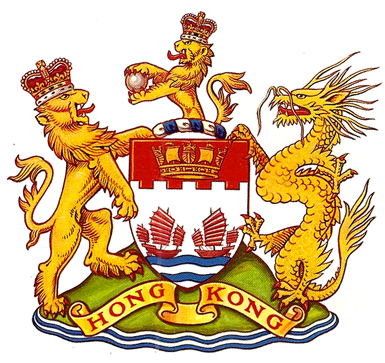
Hong Kong, 1959-1997
Crown Colony of Hong Kong (1841-1981),
British Dependent Territory of Hong Kong (1981-1997)

Registered in The Chinese Armorial, July 8, 2013
Arms: Argent on water barry wavy in base proper two three-masted Chinese junks in full sail bows inwards also proper on a chief embattled Gules a Naval Crown Or.
Crest: On a wreath Argent and Azure A demi lion Or royally crowned proper holding between the paws a pearl also proper.
Supporters: On the dexter side a lion Or royally crowned proper and on the sinister side a Chinese Dragon Gold together with a motto inscribed with the words Hong Kong.
Editor's note: all official depictions of the coat of arms have a compartment of grass Vert with waves barry wavy Azure in base, but it is not mentioned in the blazon of the Royal Warrant.
Grant: Royal Warrant, January 21, 1959.
Background and History:
Although Britain had ruled Hong Kong since 1841, the Colony had no coat of arms until over one hundred years later. Hong Kong did use a series of flag badges on the Blue Ensign to form the Colony's flags from 1869 to 1959, but these badges were not heraldic.
Edward Irvine Wynne-Jones, Postmaster General of Hong Kong1 , designed a coat of arms for Hong Kong while interned in Stanley Internment Camp during the Japanese occupation in World War II. After the war, he submitted the design to Governor Mark Young and proposed that the coat of arms replace the flag badge, at that time, a realistic depiction of the harbour with a British ship and Chinese junk in the water and, on the shore, a Chinese man and a European man shaking hands while a boy watches. In March 1947, Governor Young decided that he did "not find its [the flag badge's] quaintness particularly repulsive" and that he would not replace it.
(Editor's note: the Editor does not know what happened to Wynne-Jones' design for a coat of arms.)
In May 1958, the new Governor, Robert Black, decided to obtain a coat of arms for his Colony. A Mr. G.C. Hamilton2 designed a coat of arms, which was painted by Mr. W.E. Jones, Chief Draughtsman of the Crown Lands and Survey Office. Their design, with minor changes, ultimately became the approved coat of arms.
The Naval Crown symbolizes Hong Kong's relationship to the Royal Navy and the Merchant Navy. The embattling symbolizes the Battle of Hong Kong in 1941. The two junks symbolize Hong Kong's sea trade.
The pearl, held by the British lion, represents Hong Kong's nickname as "the Pearl of the Orient." The lion represents Britain, and the Chinese dragon represents China.
The design was approved by the Hong Kong Executive Committee on September 23, 1958, and then sent to the College of Arms. The College of Arms made some minor changes: the original design had a lion gardant, i.e., a lion facing the viewer, but the College changed it to a lion in profile so that it would not be identical the dexter supporter of the Royal Arms of the United Kingdom. The College also added a compartment of a green hill with blue and white water waves below. Editor's note: oddly, the compartment is in all official illustrations of the coat of arms, but it is not in the blazon in the Royal Warrant that approves the coat of arms!
Queen Elizabeth II approved the Royal Warrant for the coat of arms on January 21, 1959. Prince Philip, the Duke of Edinburgh, presented the coat of arms to Governor Black during his visit to Hong Kong to lay the foundation stone of the Queen Elizabeth Hospital on March 7, 1959.
On July 29, 1959, the Counsellors of State, in the absence of the Queen, approved on the Queen's behalf the use of the coat of arms on a white disc as the new flag badge in the fly of the Blue Ensign, thus creating a new flag for Hong Kong.
The non-heraldic regional emblem of the Hong Kong Special Administrative Region replaced the coat of arms for all official or government uses when Hong Kong was handed to Chinese rule in 1997. The Colonial coat of arms, however, continues to appear on privately-made souvenirs in Hong Kong.
(Information compiled from Flag Badges, Seals, and Arms of Hong Kong, by G.C. Hamilton, Government Press, Hong Kong, May 1963.)
Notes:
1 E.I. Wynne-Jones was already Postmaster General by 1941, before the Japanese occupation, according to an article in The Hong Kong Daily Press, September 11, 1941, page 1; page 5; page 6; page 7. The book Flag Badges, Seals, and Arms of Hong Kong, however, gives his wartime occupation as a "Cadet and subsequently Postmaster General", as if he became Postmaster General after the War. Jones would later design the Victory commemorative postage stamps of Hong Kong.
2 G.C. Hamilton subsequently wrote Flag Badges, Seals, and Arms of Hong Kong, the definitive book on the government emblems, flags, and coat of arms of Hong Kong, in 1963.